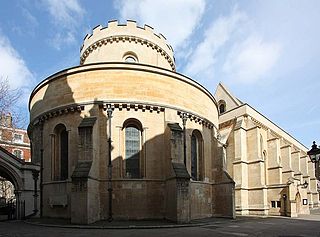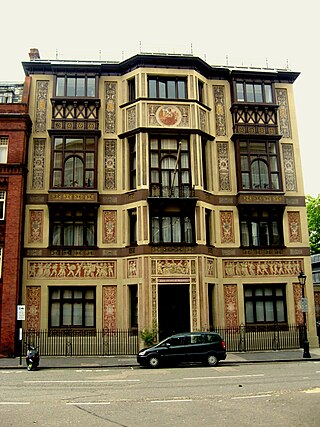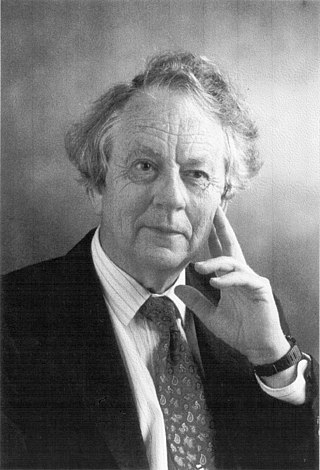
Dr. Edward John Hopkins FRCO (30 June 1818 - 4 February 1901) was an English organist and composer. [1]

Dr. Edward John Hopkins FRCO (30 June 1818 - 4 February 1901) was an English organist and composer. [1]
He was born on 30 June 1818 in Westminster. [2] He was the eldest son of George Hopkins, a clarinet player who played with the orchestra of the Royal Opera House. Two of his brothers, John and Thomas Hopkins, also became organists – John at Rochester Cathedral and Thomas at St Saviour's Church, York. His uncle Edward Hopkins was also an outstanding clarinettist and bandmaster of the Scots Guards in 1815. [3]
In 1826 he became a chorister of the Chapel Royal under William Hawes and sang at the coronation of King William IV in Westminster Abbey in 1830. At the same time, he sang in the choir of St Paul's Cathedral, having to manage his double schedule with great dexterity. On Sunday evenings, he would play the outgoing voluntary for his organ teacher Thomas Forbes Walmisley, the father of Thomas Attwood Walmisley, at St Martin's-in-the-Fields. [3] He left the Chapel Royal in 1834 and started studying organ construction at two organ factories. [3]
His first organist appointment was at Mitcham Church. He played in a blind audition against several other organists and won first place in the auditions. The committee, on seeing that he was only sixteen, were reluctant to appoint him but his friend James Turle, the organist at Westminster Abbey, where Hopkins had played as a stand-in for Turle, informed them of the fact and he was appointed. [3]
After four years at Mitcham Church, he became organist at the Church of St Peter, [4] Islington and in 1841, he became organist at St Luke's, Berwick St, Soho (demolished 1936). He held that position for two years before becoming organist at Temple Church (succeeding George Warne) which held a historic organ built in 1683 under the auspices of the Benchers. He held this position for many years. [3]
Closely associated with the Bach Society he was organist in the first English performances of Bach's St Matthew Passion under the direction of William Sterndale Bennett
In 1855 he collaborated with Edward Rimbault in the publication of The Organ: Its History and Construction. In 1864 he was one of the founders of the College of Organists, later the Royal College of Organists. [5] In 1882 he received an honorary Doctorate in Music from the Archbishop of Canterbury. [6]
He composed over 30 hymn tunes, and some psalm chants, which are widely used in the Church of England to this day.

The Temple Church, a royal peculiar in the Church of England, is a church in the City of London located between Fleet Street and the River Thames, built by the Knights Templar for their English headquarters in the Temple precinct. It was consecrated on 10 February 1185 by Patriarch Heraclius of Jerusalem. During the reign of King John (1199–1216) it served as the royal treasury, supported by the role of the Knights Templar as proto-international bankers. It is now jointly owned by the Inner Temple and Middle Temple Inns of Court, bases of the English legal profession. It is famous for being a round church, a common design feature for Knights Templar churches, and for its 13th- and 14th-century stone effigies. It was heavily damaged by German bombing during World War II and has since been greatly restored and rebuilt.

The Royal College of Organists (RCO) is a charity and membership organisation based in the United Kingdom, with members worldwide. Its role is to promote and advance organ playing and choral music, and it offers music education, training and development, and professional support for organists and choral directors.
George Guest CBE FRCO was a Welsh organist and choral conductor.

St Peter Mancroft is a parish church in the Church of England in the centre of Norwich, Norfolk. After the two cathedrals, it is the largest church in Norwich. It was originally established by Ralph de Gael, Earl of East Anglia, between 1066 and 1075. It was later rebuilt, between 1430 and 1455. It stands on a slightly elevated position, next to the market place.

Sir John Frederick Bridge was an English organist, composer, teacher and writer.
Harvey Grace (1874–1944) was an English musician: a composer, conductor, editor and teacher, best known for the 26 year period he worked as editor at The Musical Times.
Greg Morris is an English organist and conductor.
James Vivian FRCO is Organist & Director of Music at St George's Chapel, Windsor. In this role, he has been responsible for providing music at many Royal occasions including three Royal Weddings and the funerals of Prince Philip, Duke of Edinburgh, and Queen Elizabeth II. In 2022, he directed the music for King Charles III's first Christmas King's Speech.
Michael Bernard Nicholas FRCO, FRSCM is a British organist, conductor and composer, who was organist and master of choristers at Norwich Cathedral from 1971 to 1994 before becoming Chief Executive of the Royal College of Organists.
Roy Cyril Massey is a British organist and conductor.
Douglas Edward Hopkins was a cathedral organist, who served at Peterborough Cathedral and Canterbury Cathedral.
Edmund Hart Turpin was an organist, composer, writer and choir leader based in Nottingham and London.
Professor Martindale Sidwell FRCO was an English organist, composer and teacher.
James Higgs was an English organist and teacher, and the uncle of Henry Marcellus Higgs.
John Larkin Hopkins was an English organist and composer, mostly of church music.

Thomas Forbes Walmisley was an organist, and a composer of church music and of glees.

Gerald Mills Hendrie,, is an English scholar, composer, organist, pianist and harpsichordist.
St Luke's Church was an Anglican church in Berwick Street, in the City of Westminster, London. It was built in 1839, on the site of a Huguenot church of 1689 and an Anglican chapel of ease of the 18th century. It was demolished in 1936.